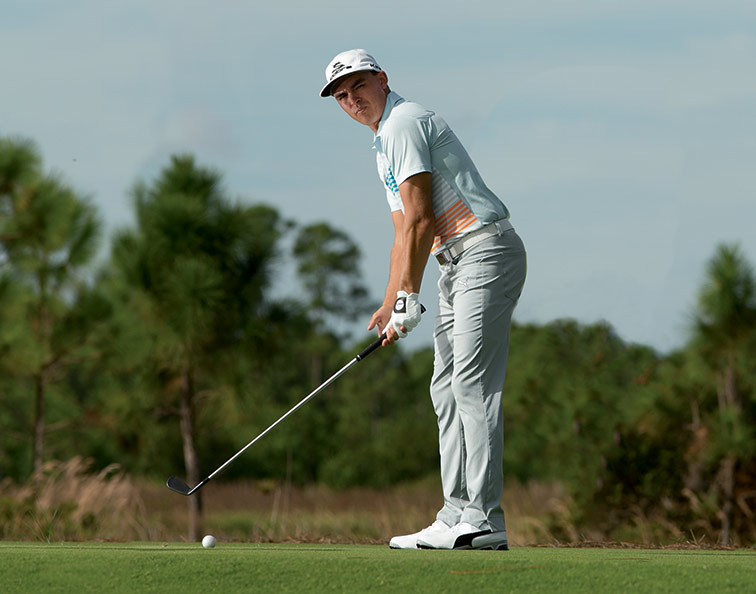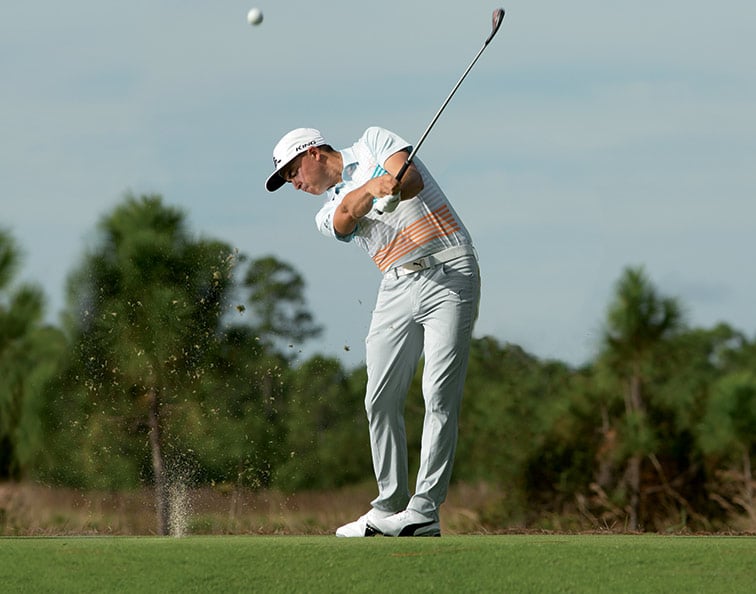The past couple seasons I’ve hit the ball more solidly than ever.
Instead of constantly trying different swing thoughts, I’ve worked with Butch Harmon to really focus my approach. With my posture at address, I always confirm that my chin is high. If your chin is stuck on your chest, there’s no room for the front shoulder to turn under it, so you’ll tend to tilt towards the target instead of loading onto your back leg. My thought on the backswing is to stay wide.
A lot of average golfers get hung up on keeping the right elbow tucked to the body. At the top of the swing, all that matters with the right elbow, Butch says, is that it points down. Swing your hands as far from your body as feels comfortable, and then just let it rip.
Waggle Like A Pro
Being meticulous with your setup is important, but my top priority over the ball is to stay loose. If I sense tension in my forearms, neck or anywhere, I get rid of it with a gentle waggle of the club back and forth. See how my thumb is off the grip? Lightly re-gripping the club a bit as I rehearse the first part of my takeaway is my go-to trick. While waggling, I stare down my target, then glance at the ball to start my swing. Struggling golfers tend to do the opposite: They’ll stare at the ball, growing tense, and glance at the target with no real commitment to the shot.

Stay Down and Extend
Through the ball, I think about maintaining the spine angle I started with at address. This helps my feet stay heavy and quiet. With a stable base, I can just fire my right side through the shot. To me, it kind of feels like I’m throwing the club and my right arm in a straight line at the target. In pro-ams, probably the most common fault I see is guys standing up at impact. They straighten both legs and get up on their toes. Without great timing, this kills your consistency. You want to extend your arms, not your legs.

Check Your Balance
I already emphasised the importance of being tension-free at the start, and the same goes for the finish. I know I’ve gone too hard if I’m straining – even slightly – to keep my balance as I watch the shot. Butch says the arms are the real indicators. It’s true, if I’ve made a good swing, my arms feel soft. If I’m out of balance, I’ll notice my arms flexing or straightening to save me from stumbling. Here, see how my right shoulder is closer to the target than my left, and the shaft is in a steady position behind my head? That’s a pure finish. I hit this one stiff.

Strokes Gained, Tee To Green
It’s kind of complicated, but this stat means I gain about a shot and a half per round on my competitors thanks to better ballstriking. Because the tour tracks every shot, they can calculate how each one compares to the field. Suppose the average drive on a given par 4 is 216 metres in the first cut of rough, and from there the average is three shots to hole out (a par). If I bust a drive 300m down the middle, this is a zone where the field might be averaging 2.7 strokes to hole out. That drive has increased my chance of making birdie by 0.3 shots. Similarly, a 9-iron to 10 feet instead of 20 is a partial gain, because we make that shorter putt more often. Golf’s about hitting more strong shots than weak ones. This stat quantifies it.
– Rickie Fowler is a Golf Digest Playing Editor and has three wins on the US PGA Tour.




